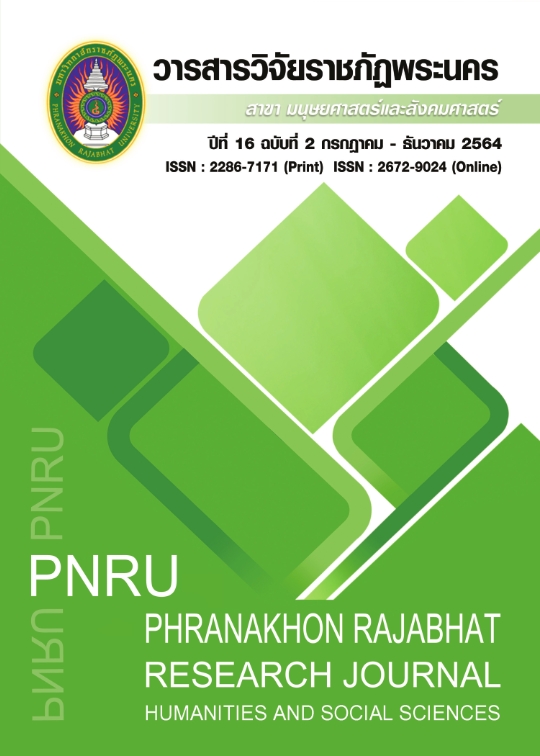USING DEEP LEARNING TECHNIQUES: THE WAYS TO DEVELOP CREATIVITY
Main Article Content
Abstract
The purpose of this academic article is to present the concept of using cognitive processes and deep learning techniques to develop creativity. The methods include: 1) setting learning goals using knowledge dimension and cognitive process dimension that are based on the concept of the reviewed Bloom’s taxonomy. Identifying the type of knowledge and the highest order of cognitive processes, or creative thinking. And 2) Designing deep learning techniques, means allowing learners to understand the prior knowledge. According to the assignment, the tasks for learning goals. Organizing learning activities for learners to understand prior knowledge, and use the prior knowledge to expand new knowledge to be clear or specific. Learners can use the learning process, which is self-directed learning, to search for information and can use any skills, that is the strategies to achieve their performance works. This is due to the use of creative thinking through deep learning of specific knowledge content. The benefits are the production or innovation that can be used to solve problems in real life.
Article Details

This work is licensed under a Creative Commons Attribution-NonCommercial-NoDerivatives 4.0 International License.
Each publish articles were copyright by Phranakorn Rajabhat University
Any contents which appeared in each articles in the journal were authors personal opinion. It did not relate to Phranakorn Rajabhat University and other instructors in the university. Each authors would take responsibility on their articles. If there are any mistake, the authors will take responsibility themselves
References
Ardianik, W.E., Izzah, N., & Kusmiyati. (2020).The Level of Students’ Creative Thinking Through Solving Open Ended Mathematics from Learning Style.Journal of Archaralogy of Egypt/ Egyptogy, 17(3), 12-24.
Backsanskij, O.E., & Dergacheva, E.A. (2013). Cognitive Processes of the Brain and Learning Theory. Advances in Economics, Business and Management Research, 128: 66-70.
Boyer, S.L., et al. (2014). Self-Directed Learning: A Tool for Lifelong Learning. Journal of Marketing Education, 36(1), 20–32.
Garrison, D.R. (1997). Self-Directed Learning: Toward a Comprehensive Model. Adult Education Quarterly, 48(1), 18-33.
Havard, B., Du, J., & Olinzock, A. (2005). Deep Learning The Knowledge, Methods, and Cognition Process in Instructor-led Online Discussion. The Quarterly Review of Distance Education, 6(2), 125–135.
Jaarsveld, S., & Lachmann, T. (2017). Intelligence and Creativity in Problem Solving: The Importance of Test Features in Cognition Research. Frontiers in Psychology, 6 February, 1-12. Retrieved from https://doi.org/10.3389/fpsyg.2017.00134. [2021, 24 May.]
Krathwohl, D.R. (2002). A Revision of Bloom’s Taxonomy: An Overview. Theory Into Practice, 41(4), 212-218.
Mnguni, L.E. (2014). The theoretical cognitive process of visualization for science education.
SpringerPlus, 3:184, 2-9. Retrieved from http://springerplus.com/content/ 3/1/184. [2021, 24 May.]
Nelson-Laird, T.F., et al. (2008). The Effects of Discipline on Deep Approaches to Student Learning and College Outcomes. Research in higher education, 49(6), 469–494.
Nuangjamnong, C., Sopaauthsawaporn, P., & Thaneepearn, A. (2020). The 21st Century
Learning Skills Framework and Project Based Learning. Journal of Suvarnabhumi Institute of Technology, 6(1), 623-640. (In Thai)
Ritter, S.M., et al. (2020). Fostering students’ creative thinking skills by means of a one-year creativity training program. PLoS ONE, 15(3), 1-18.
Sile´na, C. & Uhlin, L. (2008). Self-directed learning: a learning issue for students and faculty! Teaching in Higher Education, 13(4), August, 461-475.
Stevenson, C., Baas, M. & Maas, H. (2021). A Minimal Theory of Creative Ability. Journal of
Intelligence, 9: 9.1-18. Retrieved from https// doi.org/10.3390/jntelligence 9010009. [2021, 24 May.]
Tahir, K. (2015). Student Deep Learning In Bachelor English Programs Within Pakistani
Universities. Journal for Leadership and Instruction, Fall, August, 31-36.
Valentová, M. & Brečka, P. (2020). Ways of Critical and Creative Thinking Development in Practical Training through Video-Study. TEM Journal, 9(1), 327-334.
Wanga, X., et al. (2019). The creative thinking cognitive process influenced by acute stress in humans: an electroencephalo-graphy study. Stress, 22(4), 472–481.


